
The Battle of Blenheim fought on 13 August [O.S. 2 August] 1704, was a major battle of the War of the Spanish Succession. The overwhelming Allied victory ensured the safety of Vienna from the Franco-Bavarian army, thus preventing the collapse of the reconstituted Grand Alliance.

The War of the Polish Succession was a major European conflict sparked by a civil war in the Polish–Lithuanian Commonwealth over the succession to Augustus II the Strong, which the other European powers widened in pursuit of their own national interests. France and Spain, the two Bourbon powers, tested the power of the Austrian Habsburgs in Western Europe, as did the Kingdom of Prussia, whilst Saxony and Russia mobilized to support the eventual victor. The fighting in Poland–Lithuania resulted in the accession of Augustus III, who in addition to Russia and Saxony, was politically supported by the Habsburgs.
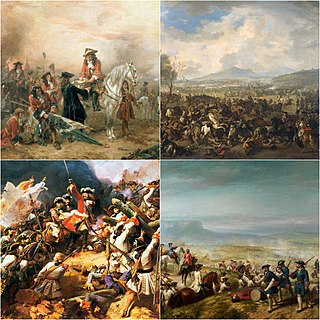
The War of the Spanish Succession was a European great power conflict fought between 1701 and 1714. The immediate cause was the death of the childless Charles II of Spain in November 1700, which led to a struggle for control of the Spanish Empire between supporters of the French Bourbons and the Habsburgs. Charles named his heir as Philip of Anjou, a grandson of Louis XIV of France, whose claim was backed by France and most of Spain. His rival, Archduke Charles of Austria, was supported by the Grand Alliance, whose primary members included Austria, the Dutch Republic, and Great Britain. Significant related conflicts include the 1700 to 1721 Great Northern War, and Queen Anne's War.
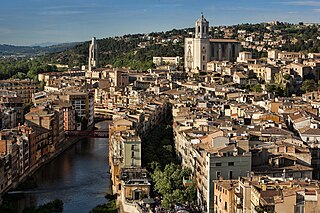
Girona is the capital city of the province of Girona in the autonomous community of Catalonia, Spain, at the confluence of the Ter, Onyar, Galligants, and Güell rivers. The city had an official population of 103,369 in 2020 but, the population of the Girona–Salt urban area is estimated to be about 156,400 (2020). Girona is also capital of the comarca of the Gironès and the vegueria of Girona. Since much of the old quarter of this ancient city has been preserved, Girona is a popular destination for tourists. The city is located 99 km (62 mi) northeast of Barcelona.

The Battle of Dettingen took place on 27 June 1743 during the War of the Austrian Succession at Dettingen in the Electorate of Mainz, Holy Roman Empire. It was fought between a Pragmatic Army, composed of the British, Hanoverian and Austrian troops, and a French army commanded by the duc de Noailles.
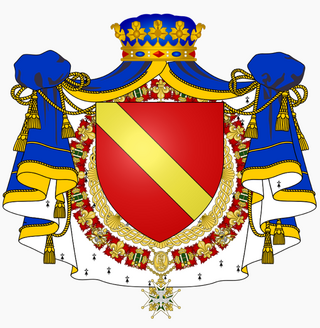
The title of Duke of Noailles was a French peerage created in 1663 for Anne de Noailles, Count of Ayen.

Adrien Maurice de Noailles, 3rd Duke of Noailles was a French nobleman and soldier.
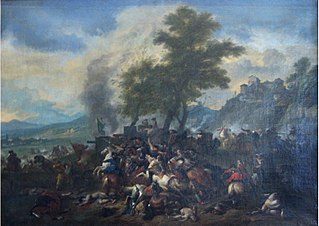
The Battle of Schellenberg took place on 2 July 1704 during the War of the Spanish Succession. The engagement was part of the Duke of Marlborough's campaign to save the Habsburg capital of Vienna from a threatened advance by King Louis XIV's Franco-Bavarian forces ranged in southern Germany. Marlborough had commenced his 250-mile (400 km) march from Bedburg, near Cologne, on 8 May; within five weeks he had linked his forces with those of the Margrave of Baden, before continuing on to the river Danube. Once in southern Germany, the Allies' task was to induce Max Emanuel, the Elector of Bavaria, to abandon his allegiance to Louis XIV and rejoin the Grand Alliance; but to force the issue, the Allies first needed to secure a fortified bridgehead and magazine on the Danube, through which their supplies could cross to the south of the river into the heart of the Elector's lands. For this purpose, Marlborough selected the town of Donauwörth.

The siege of Turin took place from June to September 1706, during the War of the Spanish Succession. A French army led by Louis de la Feuillade besieged the Savoyard capital of Turin, whose relief by Prince Eugene of Savoy has been called the most brilliant campaign of the war in Italy. The siege is also famous for the death of Piedmontese hero Pietro Micca.

The Great Siege of Gibraltar was an unsuccessful attempt by Spain and France to capture Gibraltar from the British during the American Revolutionary War. It was the largest battle in the war by number of combatants.

Colonel Daniel Parke Jr. was an American-born military officer, planter, politician and colonial administrator who served as the governor of the Leeward Islands from 1706 to 1710, when he was lynched by a mob in Antigua. Best known for his military service in Europe under the Duke of Marlborough during the War of the Spanish Succession, Parke was the only governor in Britain's American colonies to be murdered.

The Battle of Torroella, also known as Battle of the river Ter, took place during the Nine Years' War, on 27 May 1694 along the banks and fords of the Ter River near the Puente Mayor in the vicinity of the important town of Girona, Catalonia, Spain.

The third siege of Girona occurred in northern Catalonia, Spain from 6 May to 12 December 1809, during the Napoleonic Wars. A significant event of the Peninsular War, France's Grande Armée lay siege to the town of Girona for seven months. Girona was strategically important because it controlled the main road between France and Spain.

Louis d'Aubusson de la Feuillade was a French military officer and courtier who fought in the Nine Years War and the War of the Spanish Succession.
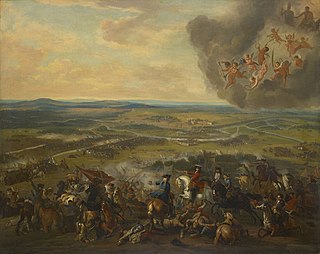
The Battle of Cassano took place on 16 August 1705, during the War of the Spanish Succession, near Cassano d'Adda, in Lombardy, Italy. It was fought between a French army of 22,000 commanded by the duc de Vendôme and an Imperial force of 24,000 under Prince Eugene of Savoy.

The Battle of Montjuïc took place between 13 and 17 September 1705 during the War of the Spanish Succession.
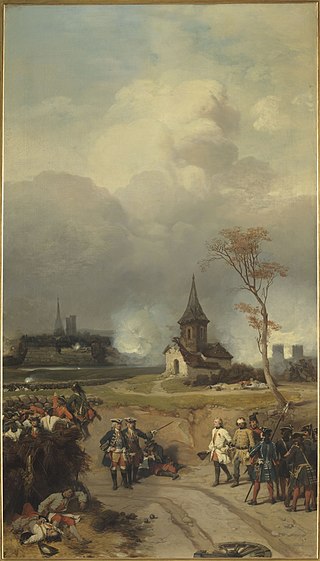
The siege of Philippsburg was conducted by French forces against troops of the Holy Roman Empire in the fortress of Philippsburg in the Rhine River valley during the War of the Polish Succession. The Duke of Berwick led 100,000 men up the Rhine Valley, of which 60,000 were detached to invest the fortress at Philippsburg, beginning on 26 May 1734. An Imperial relief army of 70,000 under the aging Prince Eugene of Savoy was unsuccessful in actually relieving the siege. On 12 June Berwick was killed by a cannonball while inspecting the trenches, and command of the besiegers fell to Marshals d'Asfeld and Noailles. The fortress surrendered one month later, and the garrison withdrew to the fortress of Mainz with the honours of war.
The Battle of Sant Esteve d'en Bas took place on 10 March 1695 in the Catalan front of the War of the Grand Alliance. It was fought between a column of French regular infantry under Brigadier Urbain Le Clerc de Juigné, governor of the nearby French-occupied Castellfollit de la Roca, and 16 companies of Catalan miquelets and several armed peasants at the orders of Ramon de Sala i Saçala, the veguer of the town of Vic. Juigné's force was in a punitive expedition to burn the village of Sant Esteve d'en Bas, whose inhabitants had refused to pay war contributions to the French army, when it was attacked by the Catalan militia and nearly destroyed in two separate engagements.

The siege of Ghent was the last operation of the 1708 campaign season during the War of the Spanish Succession. After successfully taking Lille shortly before, the Duke of Marlborough moved his forces onto the town of Ghent where after a 12-day siege the town's governor, Count Charles de La Mothe-Houdancourt, surrendered.

The assault on Nijmegen occurred during the War of the Spanish Succession, on 10 and 11 June 1702 involving French troops under the Duc de Boufflers against the small garrison and some citizens of the city of Nijmegen and an Anglo-Dutch army under the Earl of Athlone.



















